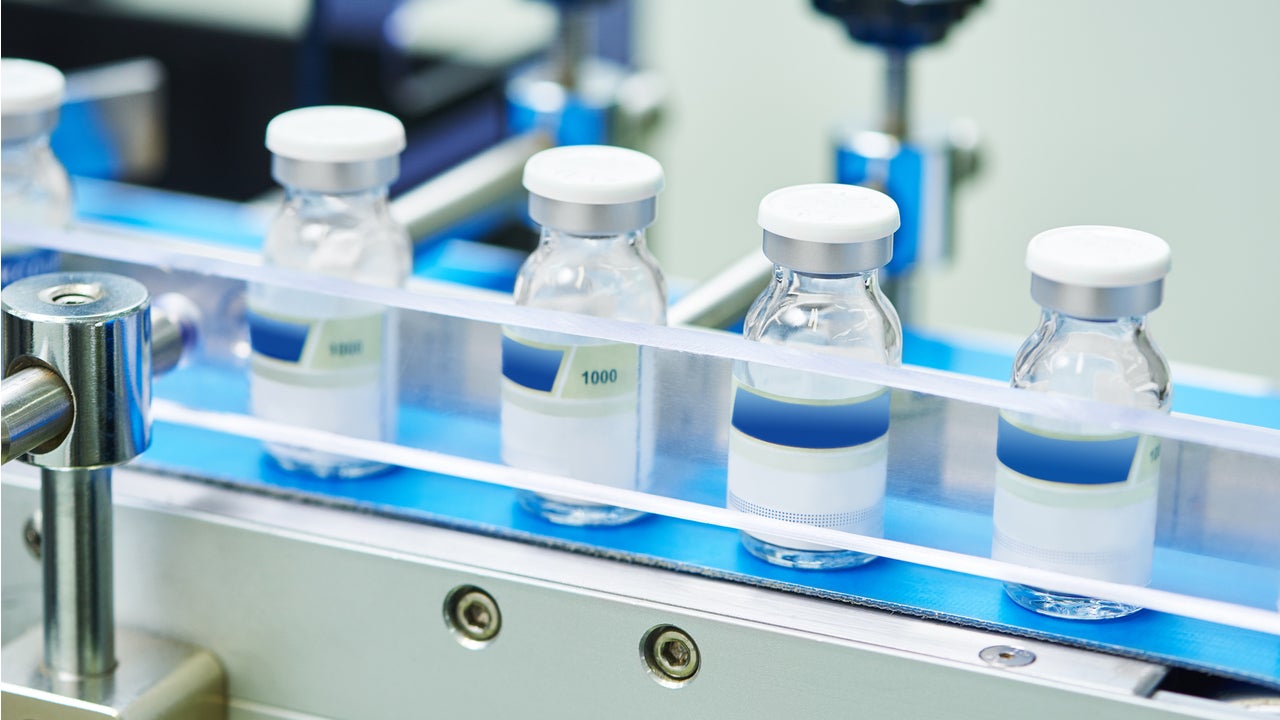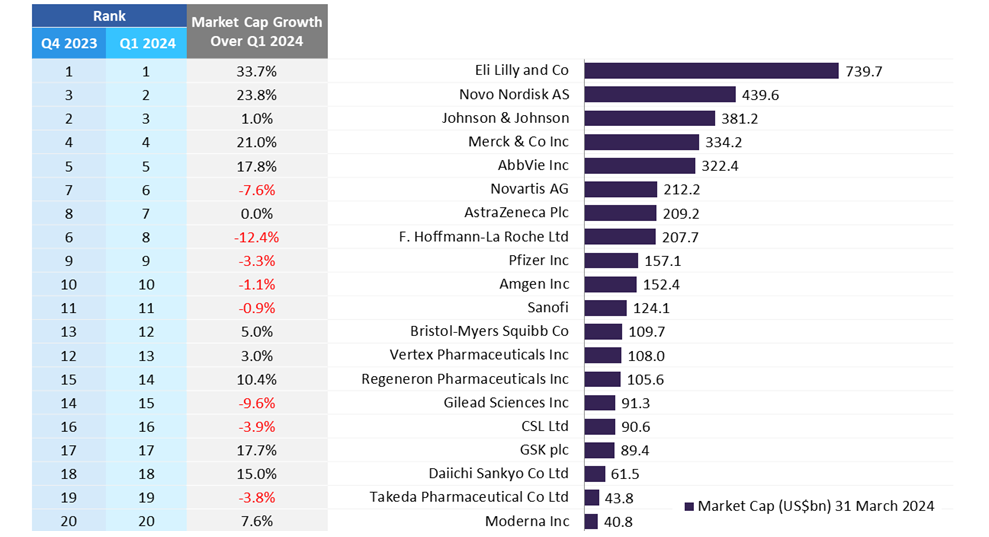
Top Pharmaceutical Companies by Revenue in 2024
In 2023, established pharma giants such as Johnson & Johnson, Roche, Merck & Co have managed to maintain their positions as the leading drug manufacturers based on their disclosed revenues.
In this analysis, Pharmaceutical Technology investigates the global top ten pharma companies as trends have shifted significantly in the pharma sector in the last few years due to the Covid-19 pandemic, rising inflation, supply chain disruptions and more.
While some companies have remained at the forefront of the global pharma industry, in the aftermath of the Covid-19 pandemic the revenues of others, such as Pfizer, have significantly dropped compared to the previous year.
From Johnson & Johnson to Bristol Myers Squibb (BMS), Pharmaceutical Technology lists the top ten pharmaceutical companies in 2023, based on their revenues.
1. Johnson & Johnson- $85.2bn
2. F. Hoffmann-La Roche Ltd- $66.4bn
3. Merck & Co – $60.1bn
4. Pfizer – $58.5bn
5. AbbVie – $54.3bn
6. Bayer – $51.9bn
7. Sanofi– $46.9bn
8. AstraZeneca – $45.8bn
9. Novartis– $45.4bn
10. Bristol Myers Squibb- $45.0bn
How well do you really know your competitors?
Access the most comprehensive Company Profiles on the market, powered by GlobalData. Save hours of research. Gain competitive edge.

Thank you!
Your download email will arrive shortly
Not ready to buy yet? Download a free sample
We are confident about the unique quality of our Company Profiles. However, we want you to make the most beneficial decision for your business, so we offer a free sample that you can download by submitting the below form
By GlobalDataSee Also:
1. Johnson & Johnson – $85.2bn
In January 2024, Johnson & Johnson (J&J) declared strong financial growth in the final quarter of 2023 (Q4 2023), as reported sales rose by 7.3% to $21.4bn in comparison to $19.9bn in the same quarter of the previous year (Q4 2022), accompanied by an operational growth of 7.2%. Moreover, overall 2023 revenues reached $85.2bn.
This growth was primarily fueled by pharmaceutical products across the areas of oncology, immunology and neurology. Specifically, growth in sales was demonstrated in oncology products such as Darzalex (daratumumab), Erleada (apalutamide), Tecvayli (teclistamab-cqyv) and Carvykti (ciltacabtagene autoleucel), along with immunology drugs Stelara (ustekinumab) and Tremfya (guselkumab), and Spravato (esketamine) in the neurology sector. However, this growth was partially offset by the decline in sales of products like Zytiga (abiraterone acetate) and Imbruvica (ibrutinib) in oncology, and Remicade (infliximab) in immunology.
This year, J&J has already received FDA approval for Balversa (erdafitinib) for the treatment of locally advanced or metastatic urothelial carcinoma in individuals carrying susceptible genetic alterations in fibroblast growth factor receptor 3. In 2024, the company projects that operational sales are set to increase by 5–6%.
2. F. Hoffmann-La Roche Ltd-$66.4bn
The pharma company with the second-highest revenues in 2023 was Roche, whose group sales rose by 1% at constant exchange rates (with a 7% decline in SFr) to amount to Sfr 58.7bn ($66.4bn).
This sales growth counteracted the effects of biosimilar erosion and the reduction in Covid-19-related sales, ultimately surpassing the guidance set for that year.
Sales in the Pharmaceuticals Division rose by 6% (excluding the Covid-19 medication Ronapreve (casirivimab/imdevimab), which saw a 9% increase driven by sustained high demand for newer medications). Leading this growth were other therapies like the eye medicine Vabysmo (faricimab-svoa), followed by Ocrevus for multiple sclerosis, Hemlibra for haemophilia A, and Polivy for blood cancer.
In contrast, sales in the Diagnostics Division decreased by 13%, primarily due to the exceptional demand for Covid-19 tests observed in 2022. However, the base business of this division showed robust momentum with a 7% increase in sales.
Some key developments during Q4 2023 and Q1 2024 include the FDA approval of Vabysmo for the treatment of retinal vein occlusion, a severe eye condition, as well as the FDA approval of Xolair, a food allergy medication. The European Union (EU) also approved a subcutaneous version of Tecentriq (atezolizumab), which is a cancer immunotherapy drug.
3. Merck & Co- $60.1bn
Merck & Co’s sales for Q4 2023 and FY 2023 demonstrated continued growth within the areas of oncology and vaccines. Specifically, in the final quarter of last year, the company secured FDA Priority Review for V116, an investigative Pneumococcal conjugate Vaccine, and for patritumab deruxtecan, which it is codeveloping with Daiichi Sankyo. Also, multiple FDA approvals were obtained across the oncology portfolio throughout the past year.
In the final quarter (global sales reached $14.6bn, marking a 6% rise compared to the same quarter in 2022. Additionally, excluding both Lagevrio’s sales as well as foreign exchange impacts, the growth observed was 13%.
Pharmaceutical product sales for FY 2023 witnessed a 3% increase, reaching $53.6bn. This growth in pharmaceutical sales was mainly fueled by elevated sales in oncology, notably with Keytruda (pembrolizumab), combined with increased sales of vaccines. Additionally, FY global sales totaled $60.1bn, reflecting a 1% increase from the previous year.
4. Pfizer- $58.5bn
In January this year, Pfizer announced a significant decrease in revenue for 2023, citing a decline in sales of Covid-19 related products. In terms of FY 2023, the company announced revenues of $58.5bn, displaying a 42% drop compared to the previous year, and similarly revenues of $14.2bn in Q4 2023, which was $10.1bn less than in the same period in 2022.
The reduced revenues were mainly attributed to an expected decrease in global revenues from its Covid-19 vaccine, Comirnaty, and antiviral drug Paxlovid (nirmatrelvir/ritonavir). A negative impact of foreign exchange rates was also noted.
However, Pfizer’s CEO, Dr. Albert Bourla, highlighted that in 2023, the company achieved an unprecedented milestone with the FDA approving nine new molecular entities including pharmaceutical products and vaccines that are forecasted to positively impact the company’s performance in the future.
5. AbbVie- $54.3bn
Abbvie’s FY net revenue also dropped in 2023, with the company reporting they had decreased by 6.4% to $54.32bn in 2023, compared to the previous year’s $58.05bn.
The company announced that the global net revenues from their immunology portfolio reached $26.14bn, showing a decline of 9.6% on a reported basis or 9.2% on an operational basis, primarily because of competition from Humira biosimilars. The oncology portfolio also witnessed a decline of 10.1% based on reported figures or 9.8% based on operational figures, totaling $5.92bn in net revenue. However, their neuroscience portfolio exhibited robust improvement, by achieving an 18.2% rise in global net revenues, reaching $7.72bn.
6. Bayer- $51.9bn
Bayer also posted a decline in sales and earnings in the company’s annual report for 2023. The company announced that its strategy will now focus on bolstering its pharmaceuticals pipeline, resolving legal matters, and decreasing debt over the next 24 to 26 months.
In FY 2023, group sales amounted to €47.64 bn ($51.9bn), with currency fluctuations resulting in a decline of approximately €2bn. The report also mentioned that Crop Science, Bayer’s agricultural business, experienced notable drops in both sales and earnings compared to the previous year, primarily attributed to reduced glyphosate prices.
However, pharmaceutical sales remained stable year-on-year at €18.08bn. The division’s recent product introductions showed substantial sales increases, namely cancer drug Nubeqa and chronic kidney disease drug Kerendia, with growth rates of 93.6% and 160.6% respectively (adjusted for currency effects and portfolio changes).
7. Sanofi- $46.9bn
Sanofi’s FY 2023 sales reported a 5.3% growth, reaching €43.07bn ($46.89bn), primarily fueled by the sales of Dupixent (dupilumab) (€10.7bn), a treatment for eczema, as well vaccine sales, which increased by 8.3%.
Vaccine sales particularly benefited from the successful launch of Beyfortus (nirsevimab-alip), which earned €547m. The Specialty Care division experienced a growth of 13.7%, driven by the performance of Dupixent and the launch of Altuviiio (efanesoctocog alfa), a hemophilia treatment, which offset and compensated for the competition from generics of multiple sclerosis drug, Aubagio (teriflunomide), across key markets.
The company also noted some key milestones that occurred in the final quarter of the year, namely the submission of an approval application for Dupixent’s use in chronic obstructive pulmonary disease (COPD) in the US, EU and China, and highlighted a robust pipeline featuring 12 potential blockbuster opportunities currently undergoing clinical evaluation.
8. AstraZeneca- $45.8bn
AstraZeneca released its strong financial performance results on the day of its 25th anniversary. Although there was a decline of $3.74m attributed to Covid-19 medicines, the company reported a total revenue $45.81bn, displaying a 6% increase from the previous year, which amounted to $44.35bn.
Excluding revenue from Covid-19 medications, the total annual revenues saw a 15% rise, while product sales experienced a 14% increase. Specifically, oncology sales displayed a significant growth of 21%. Profits after tax displayed a massive increase of 81% ($5.96bn) compared to $3.29bn in 2022.
However, the core operating profit for Q4 2023 ultimately fell short of market expectations by 14%.
Some key milestones that were highlighted by the company’s annual report included three first approvals for new molecular entities; Truqap (capivasertib), Wainua (eplontersen), Voydeya (danicopan).
9. Novartis- $45.4bn
In January this year, Novartis announced a staggering 62% increase in its net income for the FY 2023, credited to a rise in operating income and one-off favorable tax effects. The net income significantly increased from $6.04bn in the previous year to $8.6bn on constant rates.
With regards to the FY 2023, net sales reached $45.4bn, marking an increase of 8% (10% at constant currency rates), primarily due to a 16% growth in volume.
The reported sales growth was particularly driven by the sustained robust performance of Entresto (sacubitril + valsartan), Kesimpta (ofatumumab), Kisqali (ribociclib succinate), Pluvicto (lutetium Lu 177 vipivotide tetraxetan) and Scemblix (asciminib hydrochloride), which was partially offset by generic erosion mostly for Gilenya (fingolimod hydrochloride), a drug for relapsing multiple sclerosis.
Novartis’ strategy is firmly focused on four key therapeutic areas: cardiovascular-renal-metabolic, immunology, neuroscience, and oncology. Within each of these areas, the company possesses numerous significant assets which are either on their pipeline or already positioned on the market.
10. Bristol Myers Squibb- $45.0bn
BMS’ FY 2023 revenues totaled up to $45bn, driven from a 7% increase in revenues from in-line and the new products portfolio, which rose to $37.9bn.
Specifically, sales from the fourth quarter demonstrated a 1% increase, reaching $11.5bn which primarily stemmed from higher sales of new products as well as Eliquis (apixaban) and Opdivo (nivolumab). These sales compensated from the lower sales of Revlimid (lenalidomide).
The company highlighted their continuous approach to long-term improvement of their growth profile mentioning key planned acquisitions of Karuna Therapeutics and RayzeBio as well as the completion of the purchase of Mirati Therapeutics.
Currency conversions were calculated based on the exchange rates on 14 March 2024. 1SFr = $1.14, €1 = $1.09





